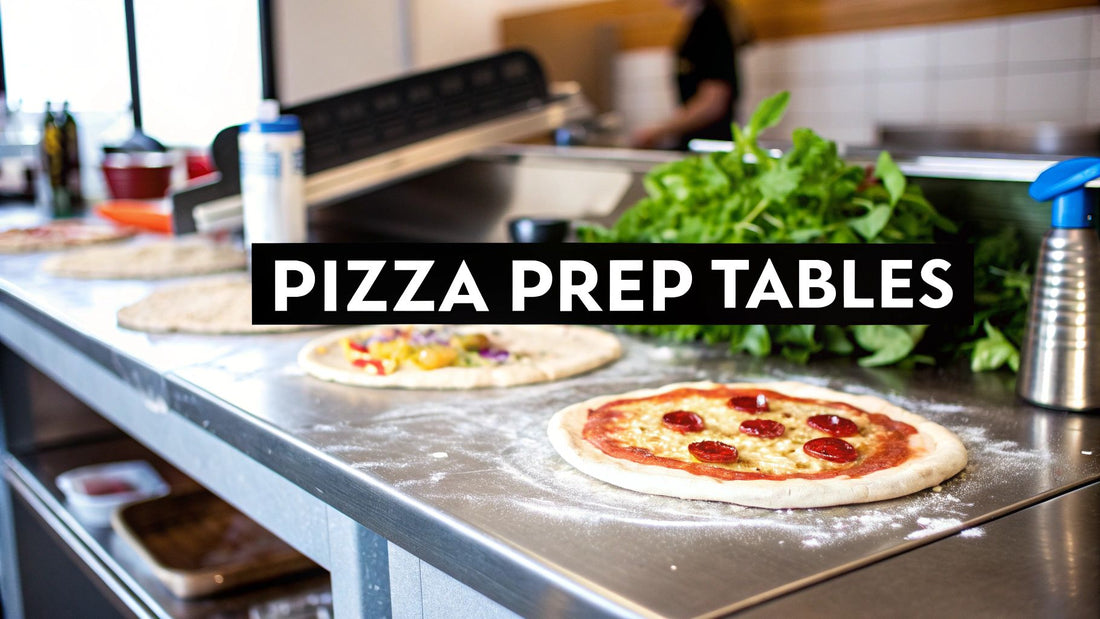
Choosing Stainless Steel Prep Tables for Pizzerias
Share
Every great pizza starts on a great surface. Think of your stainless steel prep tables as the stage where your culinary magic happens—the very first step in crafting that perfect pie. For any pizzeria owner, picking the right equipment isn't just a purchase; it's an investment in your workflow, hygiene, and the kind of consistency that keeps customers coming back for more.
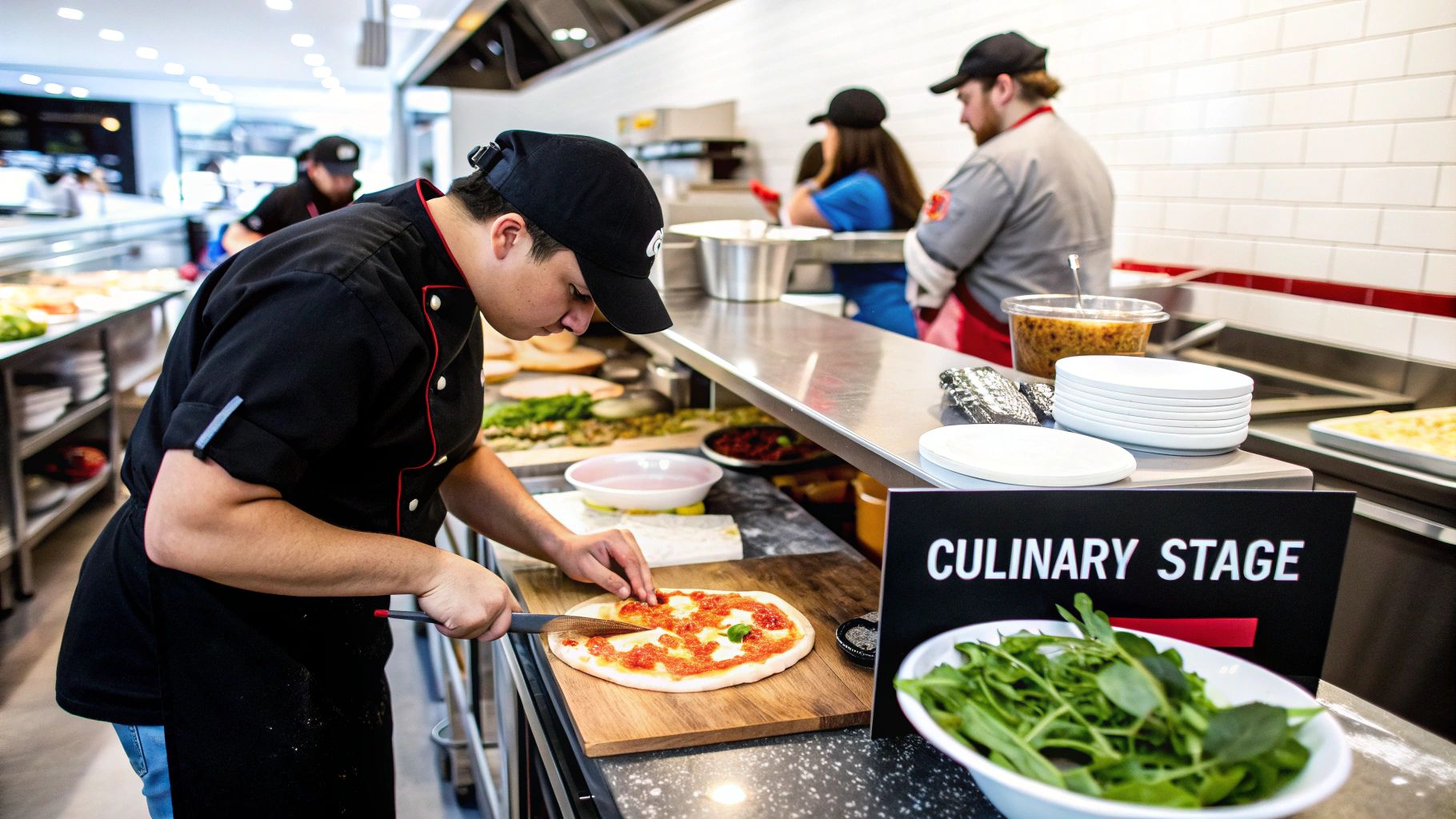
The Unsung Hero of Your Pizzeria Kitchen
In a busy pizzeria, every second and every square inch of counter space is gold. You've got a constant flow of flour, sauce, cheese, and toppings, and you need a work surface that can handle the controlled chaos of a dinner rush while meeting tough food safety standards. This is where a stainless steel prep table stops being just furniture and becomes one of the most valuable players in your kitchen lineup.
It's the reliable backbone of your entire operation, supporting everything from stretching dough to the final assembly before it hits the oven. This guide isn't about reciting generic specs; it’s about showing you how the right table directly impacts your pizzeria's success by focusing on the unique demands of making great pizza.
More Than Just a Countertop
A well-chosen prep table sends positive ripples through your entire workflow. It’s not just a place to put things; it's the key to creating an efficient, clean, and organized environment. A quality table helps you:
- Slash Prep Times: When everything is organized with proper storage, your team spends less time hunting for ingredients and more time actually crafting pizzas.
- Elevate Food Safety: Stainless steel is non-porous. That simple fact is critical for preventing cross-contamination between raw dough and ready-to-eat toppings.
- Boost Consistency: A dedicated, well-designed prep area is the secret to making sure every single pizza meets the same high standard your customers expect.
It's no surprise that the demand for this kind of durable equipment is climbing. The global food prep tables market was valued at USD 1.18 billion and is expected to hit USD 1.62 billion by 2029. That’s a clear sign that professional kitchens are putting their money into quality workstations. You can dig into more market trends on the food prep tables industry from Arizton Advisory & Intelligence.
A stainless steel prep table isn't just a purchase; it's a foundational investment in your pizzeria's efficiency and reputation. It’s the silent partner that supports every single order that leaves your kitchen, ensuring quality from the first sprinkle of flour to the final slice.
Why Stainless Steel Is Essential for Pizza Prep
In the controlled chaos of a busy pizzeria, your prep table isn't just a piece of furniture—it's the command center. It’s where every pizza starts its life, transforming from a simple ball of dough into a masterpiece ready for the heat of the oven. This is exactly why the material you choose for this surface is so critical, and stainless steel is the undisputed champ. This isn't just about looking clean and professional; it's about pure, reliable performance when the tickets start flying.
Let’s think about the alternatives for a second. A wooden prep surface might have a nice, rustic look, but wood is porous. It eagerly soaks up moisture from your dough, oils from pepperoni, and can become a breeding ground for bacteria deep within its grain. That’s a food safety nightmare waiting to happen. Plastic tables are a step up, but they scratch easily from pizza cutters and knives, creating tiny grooves where germs can hide and make proper sanitation a constant struggle.
Stainless steel is a completely different animal. Its surface is non-porous, meaning it’s a solid, impenetrable barrier. Flour, sauce, and cheese sit on top of the surface, not in it. That simple fact makes cleanup incredibly fast and effective.
The Shield Against Pizzeria Wear and Tear
A typical day in a pizza kitchen is a constant barrage of… well, everything. Tomato sauce, a core ingredient, is highly acidic. So are popular toppings like olives and various cured meats. These ingredients can absolutely destroy lesser materials, leading to stains, pitting, and slow decay over time.
Stainless steel is engineered to handle this assault. The chromium in the alloy creates a passive, self-repairing protective layer on the surface. It’s an invisible shield that fights off corrosion from acidic foods, salty cheeses, and even the tough cleaning chemicals needed to keep your kitchen up to health code standards. It's a material that doesn't just get by in a pizzeria; it thrives.
This infographic really nails down the key benefits that make stainless steel the only serious choice for professional kitchens.
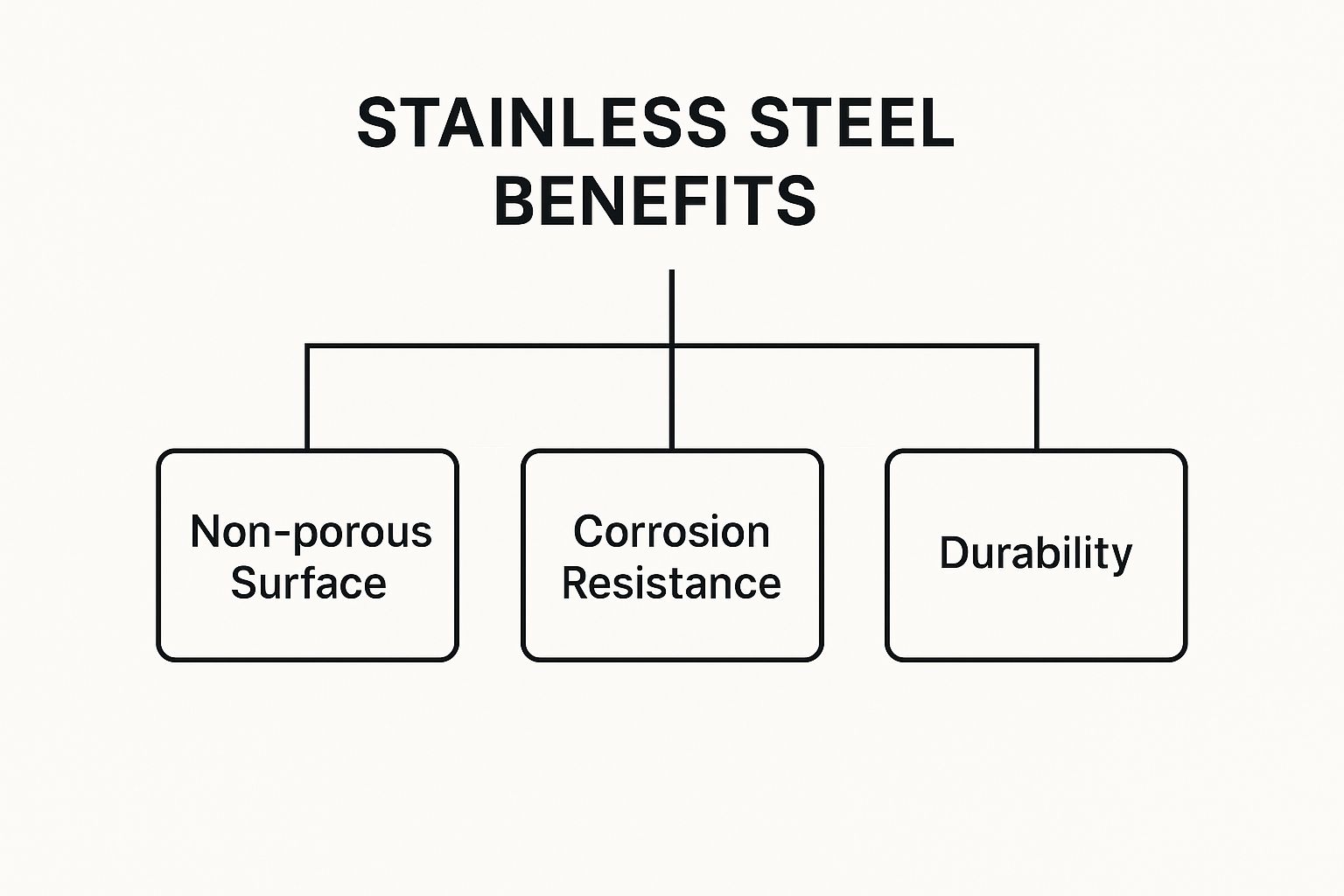
As you can see, it's the trifecta of a hygienic surface, corrosion resistance, and incredible durability that makes a stainless steel prep table so reliable.
Durability That Matches Your Busiest Rush
Beyond fending off acidic sauces, the physical toughness of stainless steel is non-negotiable for a high-volume pizzeria. Think about it: heavy bags of flour being dropped, stacks of dough boxes being slid across the surface, and hefty containers of toppings getting moved around constantly. A quality stainless steel table can take that punishment day in and day out without denting or warping.
That toughness translates directly into long-term savings. While other materials might need to be replaced or resurfaced every few years, a well-cared-for stainless steel table is a one-time purchase that can easily last the entire life of your restaurant. This is the kind of reliability that ensures your kitchen's most important workstation is always stable, safe, and ready for the next order.
A stainless steel prep table isn’t just a piece of equipment; it's a commitment to food safety, operational efficiency, and long-term quality. It provides the clean, durable, and non-reactive canvas your pizza artists need to perform at their best.
Choosing the right material is the first step toward building an efficient pizza line. The natural properties of stainless steel directly support the three pillars of any successful kitchen:
- Food Safety: Its non-porous surface is ridiculously easy to sanitize. This drastically cuts the risk of cross-contamination, which is crucial when you're handling raw dough right next to ready-to-eat toppings.
- Operational Consistency: The smooth, tough surface is perfect for stretching and handling dough, making sure every single pizza base is prepped under the same ideal conditions.
- Lasting Investment: It holds up to the brutal environment of a pizzeria, shrugging off damage from acidic ingredients, constant cleaning, and heavy use. You won't have to worry about replacing it anytime soon.
Decoding the Features of a Perfect Pizza Prep Table
When you're outfitting a pizzeria, it’s easy to look at a row of stainless steel prep tables and think they're all pretty much the same. They're shiny, they're tough, and they give you a clean surface to work on. What more is there to it? Well, as any seasoned operator will tell you, the little details are what separate a decent table from the perfect one for your specific pizza-making workflow.
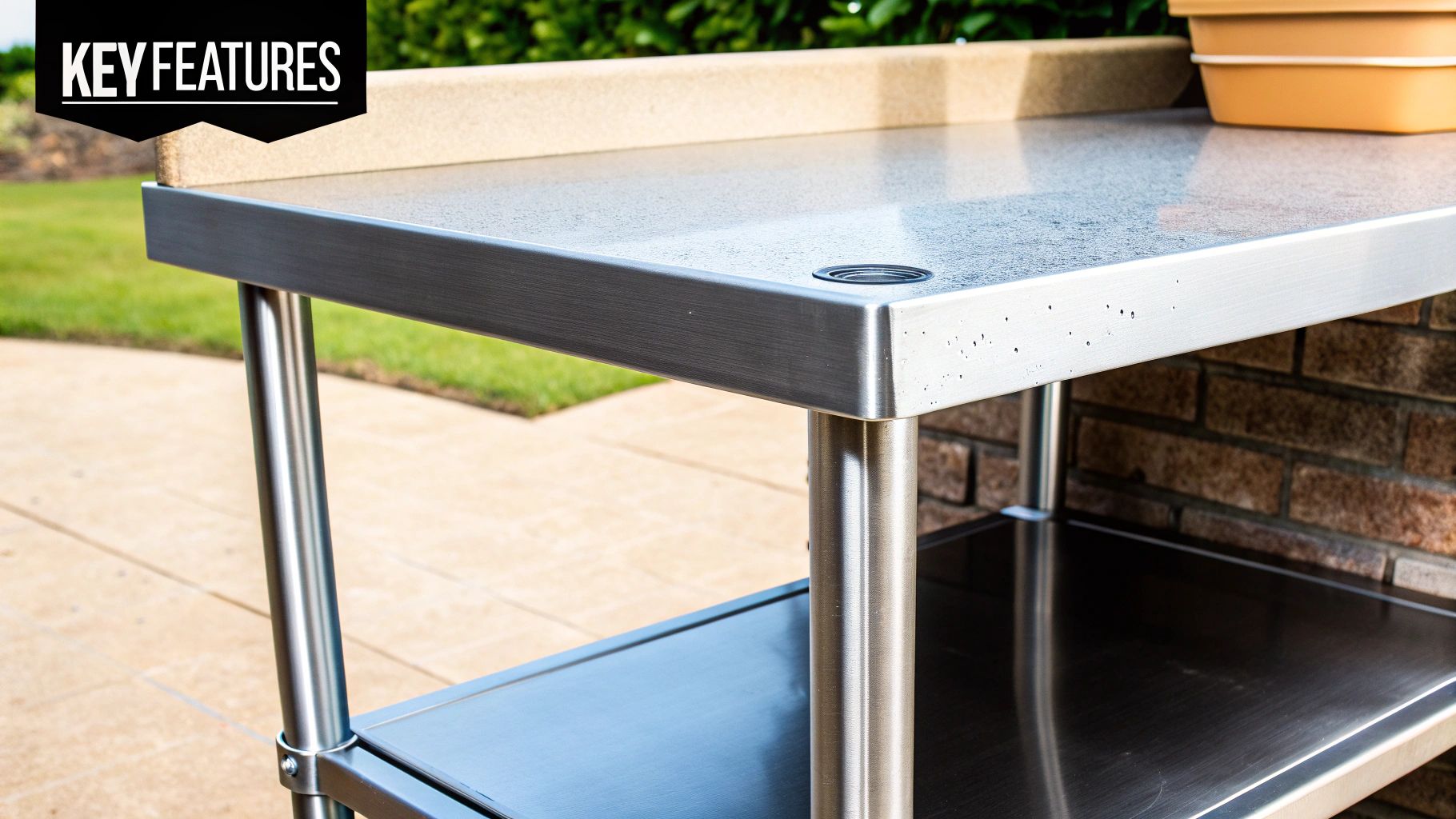
Think about it like picking the flour for your dough. Sure, it's all flour, but the protein content, the grind, and the hydration level completely change your final crust. The same idea applies here. Getting the nuances of your pizza prep table right will have a direct impact on your kitchen’s speed, safety, and cleanliness.
This growing appreciation for quality is why the stainless steel table market is steadily expanding. Valued at USD 1.2 billion, it's projected to hit USD 1.8 billion by 2033. That’s not just random growth; it shows that more and more pizzeria owners are realizing that investing in the right features pays dividends for years. You can learn more about the growing demand for quality commercial tables.
Choosing the Right Grade of Steel for Pizza
Your first big decision is the grade of stainless steel. In the world of commercial kitchens, this usually comes down to two options: 304 and 430. The difference between them is a pretty big deal for a pizzeria.
- 304 Grade Stainless Steel: This is the top-tier choice for any surface that's going to see a lot of pizza action. It has a higher mix of chromium and nickel, which gives it fantastic corrosion resistance. This is absolutely critical when you’re dealing with acidic tomato sauce, brines from olives or artichokes, and salty cured meats—all things that will eat away at lesser metals over time.
- 430 Grade Stainless Steel: This is your more budget-friendly option, and it's perfectly fine for areas with less direct food contact, like shelving for dry goods or holding equipment. It's still durable, but with less nickel, it's more likely to show wear and tear from acids and salts.
For the main station where you're stretching dough and building pies, springing for a 304-grade top is one of the smartest investments you can make. It keeps the heart of your kitchen looking pristine and standing strong for the long haul.
To make it even clearer, here's how they stack up for different pizzeria needs:
Comparing Stainless Steel Grades for Your Pizzeria
| Feature | 304 Grade Stainless Steel | 430 Grade Stainless Steel |
|---|---|---|
| Corrosion Resistance | Excellent. Resists acids from tomato sauce, vinegar, and brines. The best choice for direct food prep. | Good. Suitable for general use but can be damaged by prolonged contact with acidic or salty foods. |
| Best Use Case | Primary pizza-making surfaces, dough-stretching areas, and any high-contact prep zones. | Undershelves, equipment stands, dry storage areas, and general utility tables away from the main prep line. |
| Durability | Higher nickel content provides superior long-term durability and resistance to pitting or staining. | Strong and reliable for most tasks, but more susceptible to rust spots if not meticulously maintained. |
| Cost | Higher initial investment, but pays for itself in longevity and lower maintenance. | More budget-friendly upfront, making it a great choice for secondary surfaces. |
Ultimately, a smart strategy is to use both: 304 grade for your main battlefield and 430 grade for the supporting roles.
Essential Features for a Pizzeria Workflow
Beyond the steel itself, a few key design elements can turn a simple table into a powerhouse workstation. These aren't just nice-to-haves; they solve real problems you face every single day in a pizzeria.
A backsplash is one of the most vital features. Just picture trying to keep flour, semolina, and stray bits of cheese contained on a flat table pushed against a wall. A backsplash, even a short one, creates a barrier that keeps your ingredients on the table and your walls clean. It's a simple feature that will save you hours of cleanup.
A table without a backsplash in a pizza prep area is like a pizza peel without a handle—it technically works, but it makes the job much harder and messier than it needs to be.
Another non-negotiable feature is an undershelf. Kitchen real estate is gold, and an undershelf literally doubles your storage without eating up more floor space. It's the perfect home for dough boxes, bulk ingredient bins, or extra pizza screens, all tucked away but still within easy reach. This one addition keeps your main work surface clear and ready for action.
Safety and Ergonomics Matter for Pizza Makers
In the chaos of a dinner rush, safety features become just as important as functional ones. One detail that often gets overlooked is the edge of the table.
A bullnose edge is a smooth, rounded edge that's far safer than a sharp, squared-off one. When your crew is hustling, a bullnose edge prevents painful bumps, bruises, and ripped aprons. It’s a small touch, but it shows you’re thinking about creating a safer, more comfortable workspace for your pizza makers.
Putting these features together with the right layout is how you build a truly efficient kitchen. You can see how it all connects in our complete guide on the commercial pizza prep table.
By looking past the basic specs and zeroing in on these pizzeria-specific details, you can choose a stainless steel prep table that doesn’t just fill a space—it actively makes your entire operation better.
Finding the Right Size and Layout for Your Pizzeria
Your stainless steel prep table has to do more than just fit in an empty spot on the floor—it has to fit the unique rhythm and flow of your pizzeria. Picking the right size isn't about measurements alone. It’s about choreographing an efficient workspace that slashes wasted steps and cranks up your pizza output, especially when the dinner rush hits.
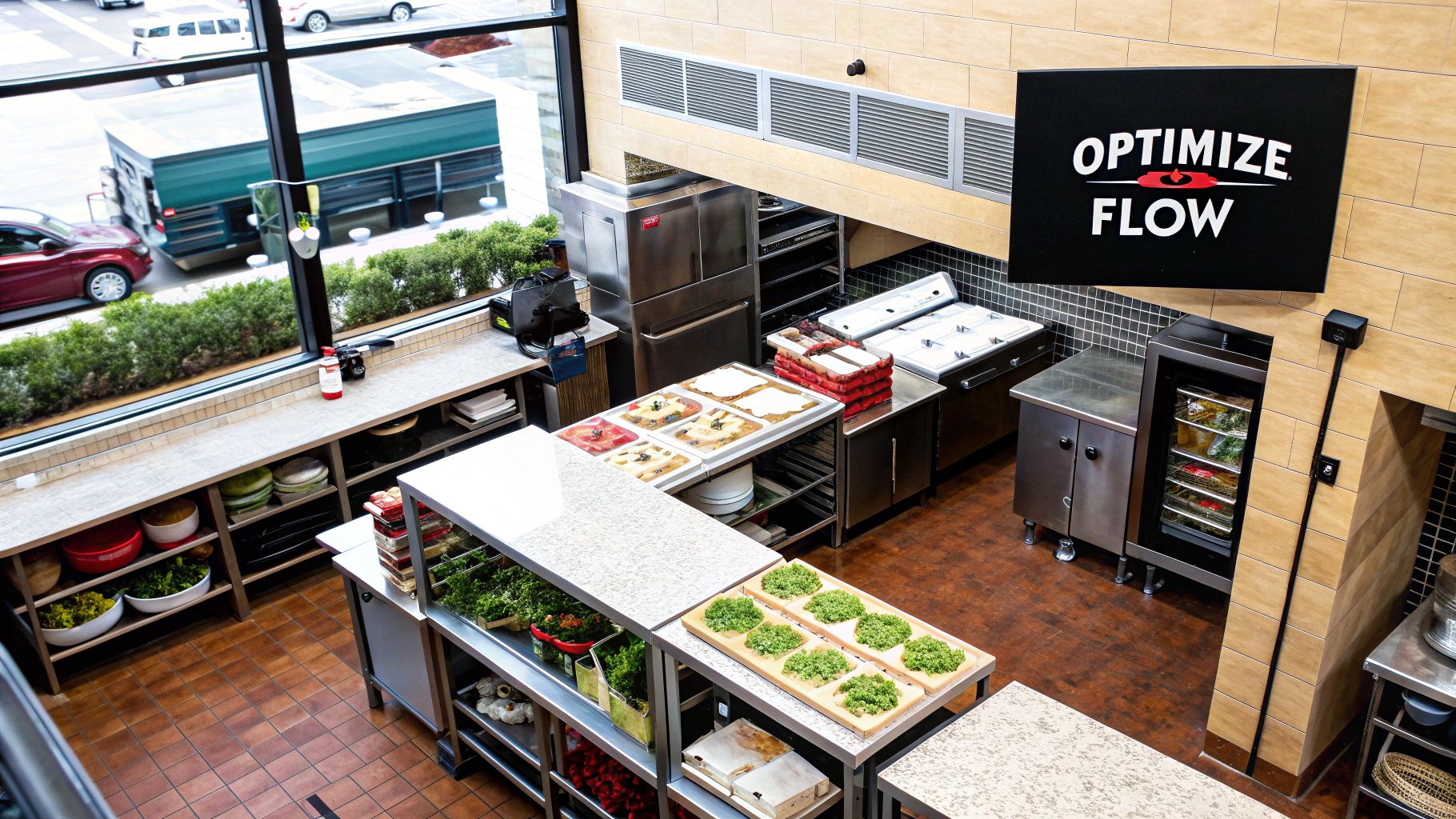
Before you even think about table dimensions, grab your tape measure and map out the area. But don't just measure the footprint for the table itself. You need to account for the clearance, that crucial breathing room your staff needs to move safely and without bumping into each other. A good rule of thumb is to leave at least 36 to 48 inches of clear pathway around any workstation to prevent traffic jams and accidents.
This initial planning is non-negotiable for a smooth workflow. For a deeper dive into optimizing your entire kitchen, there are some great resources on designing an efficient restaurant kitchen layout.
Sizing Up Your Pizza Production Needs
With your space measurements in hand, you can start looking at the most common table lengths. Each size comes with its own set of pros and cons, depending on your pizzeria’s volume and how complex your menu is.
- 48-Inch Tables: These are the compact champs, perfect for smaller kitchens, food trucks, or as a dedicated spot for one specific job, like saucing or cheesing. They're a lifesaver in tight spaces but can get crowded fast if you have more than one person trying to work.
- 60-Inch Tables: This is the versatile workhorse. A 60-inch table strikes a fantastic balance, giving a single pizza maker plenty of room to stretch dough and build pies without feeling hemmed in.
- 72-Inch Tables (and larger): For high-volume shops, a 72-inch or even a 93-inch table is the way to go. This size is a game-changer because it allows two pizza makers to work side-by-side during peak hours, effectively doubling your production capacity.
The industry's shift toward durable materials like stainless steel isn't a coincidence; it's all about efficiency and longevity. The global stainless steel market was valued at USD 214.72 billion and is expected to hit USD 310.93 billion by 2032. This growth is fueled by how essential it's become in commercial kitchens.
The right table length isn't about filling the biggest space you have. It’s about matching the surface area to your real-world production, creating a workspace that’s big enough to be efficient but not so large it creates wasted movement.
Choreographing the Perfect Pizza Line
Where you put your prep table is just as critical as its size. A smart placement is the heart of an efficient "pizza line"—a logical, straight-line flow that takes you from raw ingredients to a finished pie in the oven with the fewest possible steps.
Think of it like a well-oiled assembly line. Your prep table should bridge the gap between your ingredients and your oven.
- Dough Station: This should be at one end of the table, ideally right next to your dough proofer or storage.
- Topping Station: The main stretch of the table, positioned directly across from or next to your refrigerated prep rail for easy access.
- Oven Landing: The other end of the table should be a short, clear shot to the pizza oven.
This kind of intentional layout means your crew can stretch dough, top it, and slide it into the oven with just a step or two. It gets rid of the chaotic running around, cuts down on the risk of dropped pizzas, and shaves precious seconds off every single order. A well-thought-out setup is a cornerstone of any great commercial kitchen layout design.
When you combine precise measurements with a strategic layout, your simple piece of equipment becomes a powerhouse of productivity. Your stainless steel prep table transforms into the central hub that sets the pace for your entire operation.
Maintaining Your Table for Peak Pizza Performance
Think of your stainless steel prep table as a long-term investment in your pizzeria's future. Just like a well-seasoned pizza oven, it needs consistent care to perform at its best, day in and day out. This isn't just about looking good; proper maintenance is what protects the chromium layer that shields the steel from corrosion, guarantees top-tier hygiene, and keeps your pizzeria looking professional for years.
If you let acidic tomato sauce, salty cheese, and greasy toppings sit on the surface, they'll slowly eat away at it. The good news is that a simple cleaning playbook can stop this damage before it starts, turning a daily chore into a habit that protects your gear. These routines are all about safeguarding your investment and making sure your workspace is always a safe, pristine surface for crafting perfect pizzas.
Your Daily Cleaning Routine
Consistency is everything. Spending just a few minutes cleaning at the end of each shift prevents residue from drying, hardening, and becoming a much bigger headache later. This daily reset is absolutely vital for dealing with the constant barrage of flour, sauce, and grease in a busy pizza kitchen.
Your goal is simple: get rid of all the food particles and oils without scratching up the protective finish.
- Clear the Surface: First thing, get all your tools, containers, and loose debris like flour and cornmeal off the tabletop and undershelf.
- Initial Wipe-Down: Grab a soft, damp cloth or a non-abrasive sponge. Use warm water and a mild detergent to wipe down the entire surface. Always, always wipe in the direction of the steel's grain to avoid creating tiny scratches.
- Sanitize: Apply a food-safe, non-chlorine sanitizer, following the manufacturer's directions to the letter. You have to avoid chlorine-based cleaners—they can break down the steel's protective layer.
- Rinse and Dry: Rinse the surface thoroughly with clean water to get rid of any cleaning residue. The final step is crucial: dry the table completely with a microfiber cloth or paper towels. This prevents those annoying water spots and streaks.
Weekly Deep-Cleaning Tasks
Once a week, you need to set aside a little extra time for a more thorough cleaning. This is your chance to tackle any stubborn buildup that daily wipes might have missed, like greasy films or dried-on sauce, and restore your table's original shine.
Start by hitting any baked-on food. A simple paste made from baking soda and water works wonders for lifting stubborn cheese or sauce without scratching the surface. Just apply the paste, let it sit for 15-20 minutes, then gently scrub with a soft nylon brush before wiping it clean. For more in-depth tips on keeping your surfaces spotless, it's worth checking out what is a good cleaner for stainless steel.
The secret to a long-lasting stainless steel prep table isn't about using harsh chemicals; it's about frequent, gentle cleaning with the right tools. Consistent care prevents minor spills from becoming permanent problems.
Addressing Common Pizzeria Issues
Even if you’re diligent, small issues can pop up. Knowing how to handle them quickly is what separates the pros.
- Minor Scratches: Don't panic. Light scratches can often be buffed out using a non-abrasive cleaning pad and a specialized stainless steel polish. Just remember to always work with the grain.
- Surface Rust (Pitting): If you see little orange or brown spots, it's usually from prolonged contact with acidic foods or harsh chemicals. You need to address it immediately with a baking soda paste or a specialized, non-abrasive cleaner to stop it from getting worse.
- Fingerprints and Smudges: Oily smudges are an easy fix. A glass cleaner sprayed onto a microfiber cloth, followed by a quick wipe-down, will get rid of them in seconds.
These habits aren't just for your prep table; they're pretty similar to what's needed for other kitchen equipment. In fact, many of the same principles apply when you need to figure out the best way to clean a stainless steel refrigerator. By adopting this simple maintenance playbook, you'll ensure your stainless steel prep table stays a hygienic, reliable, and professional-looking asset in your pizzeria for its entire lifespan.
Common Questions About Pizza Prep Tables
Running a pizzeria means you're constantly making decisions, and picking the right equipment can feel like a high-stakes game. Your stainless steel prep table isn't just a piece of metal; it’s the stage where every single pizza you sell comes to life.
I’ve been in countless kitchens and the same questions always pop up. Getting the right answers from the start means you end up with a table that’s a true workhorse, not a headache. Let's walk through some of the most common ones I hear from pizzeria operators.
What Gauge Steel Is Best for a Pizzeria Prep Table?
When you start comparing tables, you’ll see the word “gauge” everywhere. It’s simply a measure of the steel's thickness, and the rule is a little counterintuitive: the lower the number, the thicker and tougher the steel. For a busy pizzeria, this is a detail you can't afford to get wrong.
For the tabletop—where you're slinging dough, sliding heavy ingredient bins, and maybe dropping a tool or two—16-gauge stainless steel is the sweet spot. It’s the perfect blend of muscle and value, tough enough to shrug off dents and warping from the daily grind.
You might see 18-gauge tables that are a bit cheaper, but that thinner steel is better suited for lighter work, like undershelves holding paper goods. Investing in a 16-gauge top from the get-go is the smart move; it’s built to handle the constant abuse of a commercial pizza kitchen for years to come.
Think of it like a pizza peel. An 18-gauge table is like a thin, aluminum peel—fine for occasional use. But for a professional pizzeria, you want the 16-gauge equivalent: a thick, sturdy wooden peel that can handle the heat and weight, night after night.
Can I Put a Small Countertop Pizza Oven on My Table?
This question comes up all the time, especially when kitchens are tight on space or need a secondary oven for gluten-free pies or appetizers. The short answer is: yes, usually you can. But you have to do your homework first.
The first thing to check is the table's official weight capacity. A quality, heavy-gauge table is built to hold a serious amount of weight, but you must confirm the manufacturer’s specific limit before putting a heavy piece of equipment on it. Never guess.
Once you’ve confirmed the weight is good to go, make sure the table is perfectly level and stable. While steel handles heat well, I always recommend placing a heat-resistant mat under the oven. It's a small, smart precaution that protects the table's finish and gives you one less thing to worry about during a chaotic dinner rush.
How Do I Remove Baked-On Cheese Without Scratching the Surface?
Ah, the classic pizzeria problem: baked-on cheese and sauce that seems fused to the table. It’s tempting to grab the nearest metal scraper or steel wool, but that’s the quickest way to permanently damage your table’s protective surface. The real trick is using a little patience and the right tools.
Here’s a simple, scratch-free method that actually works:
- Scrape Smart: First, gently lift off any loose bits with a plastic or nylon scraper.
- Make a Paste: Mix baking soda with a little water until you have a thick paste. Slather it right on the stubborn spot.
- Let It Work: Give the paste about 15-20 minutes to do its thing. The baking soda will break down the crusty food without any harsh chemicals.
- Wipe It Out: Using a microfiber cloth or a non-abrasive sponge, wipe the area clean. Always wipe with the grain of the steel, not against it. For really tough messes, a food-safe commercial degreaser can also be a big help.
Are Casters a Good Idea for a Pizza Prep Table?
Casters—or wheels—can be a huge asset, but it really boils down to how your kitchen operates. For many pizzeria owners, they offer a couple of major advantages.
The first is pure flexibility. With casters, you can move your table to reconfigure the kitchen for a deep clean, test out a new workflow, or make room for temporary equipment. That kind of mobility is priceless in a kitchen where things are always changing.
The second, and maybe most important, benefit is cleaning. Rolling the table away from the wall makes it a thousand times easier to get to all the flour, cheese, and toppings that inevitably end up underneath and behind it.
But here’s the crucial part: if you go with casters, they absolutely must be heavy-duty and have locks that actually work. During prep, that table needs to be rock-solid. A wobbly prep station is not just annoying, it's a safety hazard. If your table is going to live in one spot forever, traditional legs will always give you the most stability.
At Pizza Prep Table, we know that great pizza starts with great equipment. We’ve helped thousands of operators find the right foundation for their kitchen. From compact tables for tight spaces to massive workstations for high-volume shops, we have a durable, NSF-compliant table that will fit your needs and budget. Explore our collection and find the perfect stainless steel prep table for your operation at https://pizzapreptable.com.
